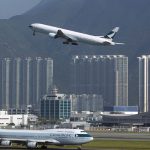
The shock of the double-attack on the Maersk Hangzhou on Sunday has prompted the Danish shipping line to follow other leading container shipping lines and divert their vessels away from the Suez Canal and sail around the Cape of Good Hope, in a move that will immediately impact the availability of space and equipment in Asia.
The earlier targeting of vessels tied to Israel has clearly ended, putting any ship, regardless of their nation status, in danger and while the coalition forces are successful in intercepting air-based weapons, without a protection regime that guarantees freedom of navigation through the Gulf of Aden and Red Sea, container shipping lines will continue to divert around the Cape of Good Hope route, adding 3,500 miles and 10 days additional transit for shippers to Northern Europe and the US East Coast.
Emerging issues include:
RATES
Spot rates have jumped to levels not seen in more than a year, with Asia to Europe rates rising 80% in a week, Asia to US West Coast climbing 40% and Asia to East Coast up 25%. Prices on unrelated trades are also being impacted, as vessels are reallocated to fill schedule gaps.
SURCHARGES
The shipping lines have been steadily introducing a range of surcharges since November, including Red Sea surcharges, War Risk Surcharge, Emergency Risk Surcharge, and Contingency Surcharges. We work tirelessly to protect our customers from these costs and challenge the lines on every occasion.
ETA
Vessels are turning off their AIS identifying locators for security reasons and though this makes tracking difficult, our Clarity ocean tracking system continues to predict updated ETAs.
TRANSIT
Extending total service transit times for Asia-US and Asia-Europe loops by +20 days means that schedule reliability is going to fall, with massive delays and backlogs anticipated.
CAPACITY
With services extended by two weeks (and possibly longer) each way, the shipping lines are adding more vessels, but with the number of additional vessels required possibly representing >5% of the global fleet, capacity will quickly be constrained, potentially falling by a third very quickly, which means upwards pressure on rates.
CONGESTION
Lines that paused vessels for 6-8 days are now diverting, but that now means extended transit times of 20 days and they are bunching up, which means congestion and berthing issues at arrival ports.
EQUIPMENT
With containers sitting on vessels for an additional 25 days, plus whatever time they spend in ports, we will quickly see container shortages grow in Asia and it is inevitable that this will spread to other regions, as their containers are moved to cover Asia’s shortfall.
AIR
Air cargo volumes increased in the last quarter and are likely to increase significantly as shippers transfer cargo away from sea, with rates already rising and a spike very likely ahead of CNY.
With the likelihood of significant sea freight disruption spreading, providing us with your shipment forecasts will help us secure the capacity and equipment you need at the best rates.
We are monitoring individual vessels and routes, to keep customers informed and urge you to contact your account team or manager directly, if you have questions about a live shipment, or want to discuss upcoming consignments.
If you have any questions or concerns about the developments outlined here, please contact your regional team.





